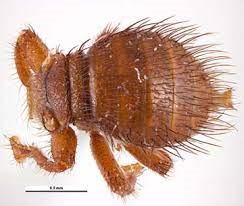Braula fly
Braula fly (Braula coeca) is a small species of wingless fly that lives in honey bee colonies and looks similar to Varroa and Tropilaelaps mites when viewed with the naked eye.
Braula fly larvae damage the appearance of wax cappings on honeycomb and adult Braula flies steal small amounts of food from adult honey bees. Heavy infestations can also lead to queen supersedure.
Braula fly is currently widespread overseas and has been reported from all continents. In Australia it is established in Tasmania, Victoria and New South Wales.
Although established in Victoria it remains a notifiable pest under the Livestock Disease Control Act 1994 and beekeepers must report suspected Braula fly.
Due to its similar appearance to Varroa and Tropilaelaps mites – notifying of suspected Braula will help prevent a detection of an exotic mite being overlooked.
Braula fly in Victoria
Braula fly is widespread overseas. In Australia it was only established in Tasmania, but since its detection in multiple apiaries in Victoria in August 2022, Braula fly is now considered established in Victoria and New South Wales.
Braula fly remains a notifiable pest in Victoria under the Act. Braula fly is also a notifiable honey bee pest across all other states and territories of mainland Australia, with beekeepers required to report the detection or suspicion of this pest to government authorities.
If any beekeeper suspects they have seen Braula fly in hives, you must report it by calling the Exotic Plant Pest Hotline on 1800 084 881.
What is Braula fly?
Braula fly lives in honey bee colonies and attaches itself to honey bees where it feeds on nectar and pollen at the honey bee’s mouth and on material secreted by the host. Its presence may reduce the egg-laying capacity of queen bees resulting in queen supersedure and could make the detection of other exotic external parasitic mites difficult.
What does it look like?

Braula fly is a small (0.9 mm wide by 1.5 mm long) wingless fly that is visible with the naked eye. It is red-brown, covered in hairs, and has six legs, with feet that have a number of comb like teeth or claws enabling them to grip fast to the hairs of the bees body . Braula fly lay small eggs (0.84 mm by 0.42 mm) throughout the hive, however, only the eggs deposited on capped honeycomb will hatch.
The hatched larvae tunnel under the cappings leaving narrow tracks about 1 mm wide across the surface of the comb. This tunnelling gives the comb a fractured appearance, a key characteristic of Braula fly presence.

What other pests can Braula be confused with?
Braula fly can be confused with the exotic parasitic Varroa mites (Varroa destructor and V. jacobsoni) and tropilaelaps mites (Tropilaelaps clareae and T. mercedesae).
Varroa destructor is now established in Australia. Varroa jacobsoni and Tropilaelaps mites (Tropilaelaps clareae and T. mercedesae) are not present in Australia.

Adult female varroa mites are oval, flat, red-brown, and 1 mm long and 1.5 mm wide.
Tropilaelaps mites are red-brown mites which are around 1 mm long and 0.5-1 mm wide.
Braula fly could also be confused with pollen mites (Mellitiphis alvearius) which are light brown and around 0.75 mm long and 0.75 mm wide. Pollen mites are naturally found in Australian hives and are not harmful to honey bees.
How is it spread?
Braula fly can spread through swarming or absconding honey bee colonies and drifting honey bees. Braula fly can also spread through the interchange of hive components from apiary to apiary, as well as the movement of hives. The larvae can also be spread by the removal and transport of infected honeycomb.
What should beekeepers look out for?
Braula flies have a preference to attach to queen bees but are regularly observed on drones and worker bees.
Hives should be thoroughly and regularly checked paying close attention to the queen bee. Beekeepers should also inspect capped honeycomb for tunnelling damage as this might be an indication of the presence of Braula fly.

How can beekeepers protect their hives from Braula fly?
Beekeepers are advised to visually inspect and monitor their hives regularly and consider the following control measures:
- Test for exotic pests – look for varroa mite, tropilaelaps, and Braula fly using visual inspection, sugar shake test, alcohol wash test, and brood uncapping methods.
- Freezing (-15°C) comb honey for at least 24 hours will kill all life stages of the Braula fly.
- The normal practice of extracting honey is another effective means to control the larval stage of the Braula fly as the eggs and larvae are removed with the wax cappings and can be processed (frozen or melted).
Reporting a honey bee pest or disease
Report any unusual pest or disease of honey bees immediately using our online reporting system or by calling the Exotic Plant Pest Hotline on 1800 084 881. Early reporting increases the chance of effective control and eradication.
Please take multiple good quality photos of the pests or symptoms of disease to include in your report where possible, as this is essential for rapid pest and disease diagnosis and response.
Your report will be responded to by an experienced staff member who may seek more information about the detection and explain next steps.
Report nowImages
Fig 1. Simon Hinkley and Ken Walker Museum Victoria, PADIL
Fig 2. NSW DPI
Fig 3. The Food and Environment Research Agency (Fera), Crown Copyright
Fig 4. The Food and Environment Research Agency (Fera), Crown Copyright